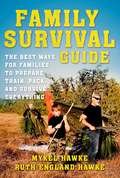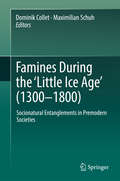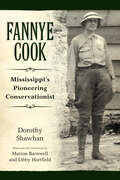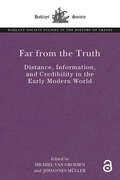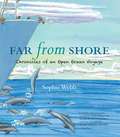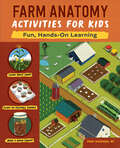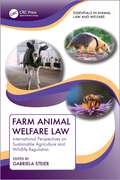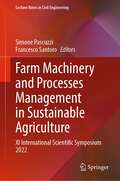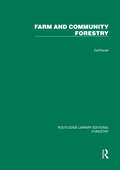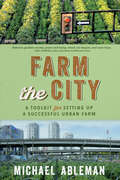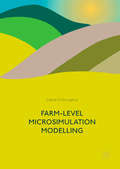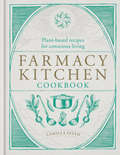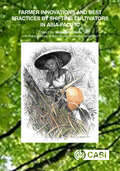- Table View
- List View
Family Survival Guide: The Best Ways for Families to Prepare, Train, Pack, and Survive Everything
by Mykel Hawke Ruth England HawkeAre you prepared in case disaster strikes? Are your kids? In the Family Survival Guide, veteran adventurers Mykel and Ruth Hawke provide the vital information you and your family need to get through almost any disaster safely. The topics covered are wide-ranging and easy-to-follow. Here, you and your family will learn: How to find, purify, and store water How to construct different types of shelter and the perfect places to build them What to pack and what not to pack in a bugout bag Essential first aid skills How to navigate your way when lost How to build a fire Basic foraging, hunting and outdoor cooking skills And so much more! Filled with expert advice and time-tested tips, Family Survival Guide is an essential handbook
Famines During the ʻLittle Ice Ageʼ (1300-1800)
by Dominik Collet Maximilian SchuhThis highly interdisciplinary book studies historical famines as an interface of nature and culture. It will bring together researchers from the natural and social sciences as well as the humanities. With reference to recent interdisciplinary concepts (disaster studies, vulnerability studies, environmental history) it will examine, how the dominant opposition of natural and cultural factors can be overcome. Such an integrated approach includes the "archives of nature" as well as "archives of man". It challenges deterministic models of human-environment interaction and replaces them with a dynamic, historicising approach. As a result it provides a fresh perspective on the entanglement of climate and culture in past societies.
Fannye Cook: Mississippi's Pioneering Conservationist
by Dorothy ShawhanMississippi Chapter of The Wildlife Society Outstanding BookConservationist Fannye Cook (1889-1964) was the most widely known scientist in Mississippi and was nationally known as the go-to person for biological information or wildlife specimens from the state. This biography celebrates the environmentalist instrumental in the creation of the Mississippi Game and Fish Commission (now called the Mississippi Department of Wildlife, Fisheries, and Parks) and the Mississippi Museum of Natural Science.To accomplish this feat, Cook led an extensive grassroots effort to implement game laws and protect the state's environment. In 1926 she began traveling the state at her own expense, speaking at county fairs, schools, and clubs, and to county boards of supervisors on the status of wildlife populations and the need for management. Eventually she collected a diverse group of supporters from across the state. Due to these efforts, the legislature created the Mississippi Game and Fish Commission in 1932. Thanks to the formation of the Works Progress Administration in 1935, Cook received a WPA grant to conduct a comprehensive plant and animal survey of Mississippi. Under this program, eighteen museums were established within the state, and another one in Jackson, which served as the hub for public education and scientific research.Fannye Cook served as director of the Mississippi Museum of Natural Science until her retirement in 1958. During her tenure, she published many bulletins, pamphlets, scientific papers, and the extensive book Freshwater Fishes of Mississippi.
Far From the Truth: Distance, Information, and Credibility in the Early Modern World
by Johannes Müller Michiel Van GroesenInformation and knowledge were essential tools of early modern Europe’s global ambitions. This volume addresses a key concern that emerged as the competition for geopolitical influence increased: how could information from afar be trusted when there was no obvious strategy for verification? How did notions of doubt develop in relation to intercultural encounters? Who were those in the position to use misinformation in their favour, and how did this affect trust? How, in other words, did distance affect credibility, and which intellectual and epistemological strategies did early modern Europe devise to cope with this problem? The movement of information, and its transformations in the process of gathering, ordering, and disseminating, makes it necessary to employ both a global and a local perspective in order to understand its significance. The rise of print, leading to various new forms of mediation, played a crucial role everywhere, inspiring theories of modernization in which media served as agents of new connections and, eventually, of globalization. Paradoxically, during the entire period between 1500 and 1800, the demise of distance through various strategies of verification coincided with constructions of otherness that emphasized the cultural and geographical difference between Europe and the worlds it encountered. Ten leading scholars of the early modern world address the relationship between distance, information, and credibility from a variety of perspectives. This volume will be an essential companion to those interested in the history of knowledge and early modern encounters, as well as specialists in the history of empire and print culture.
Far from Shore: Chronicles of an Open Ocean Voyage
by Sophie WebbIn extremely deep waters (two miles deep), the vast sea appears empty. But as naturalist and artist Sophie Webb shows us, it is full of fascinating—yet difficult to study—life. Together with her shipmates, Sophie counts and collects samples of life in the deep ocean, from seabirds to dolphins, from winged fish to whales. Only their long-term field work can really help scientists determine the health of these remarkable creatures who need the clean deep ocean to survive.
Farm Anatomy Activities for Kids: Fun, Hands-On Learning (Anatomy Activities for Kids)
by Dawn AlexanderHelp kids ages 8 to 12 discover how awesome and fun farms can beNo matter where you live, you can learn all about the amazing things that happen on farms. Farm Anatomy Activities for Kids combines the joy of hands-on experiments and activities with easy-to-understand lessons that teach you all about farm life.This farm anatomy activity book helps you think more like a farmer and understand how nature, crops, and animals shape the way we live. You'll learn about all the different parts of a farm, the plants and animals you might find there, and how farms create the food you eat and the material for the clothes you wear.Farm Anatomy Activities for Kids includes:Educational lessons—Learn about the various parts of a farm, how they raise plants and animals, and the ways farms connect to your daily life no matter where you live.Ways to play—Try out cool experiments like growing crops without soil or making a mason bee house.Journal prompts—Reflect on what you've learned about farm anatomy with the thoughtful writing prompts paired with each activity.Take kids on an educational journey down to the farm without ever leaving home.
Farm Animal Welfare Law: International Perspectives on Sustainable Agriculture and Wildlife Regulation (Essentials in Animal Law and Welfare)
by Gabriela Steier Sahana Ramdas Christian Mulgrew de Laire Audrey Amescua Amanda G. Verkest Morgan BoutilierThis book introduces the various aspects of international farm animal protection and wildlife conservation through the lenses of food safety and environmental protection law. Bite-sized chapters focus on a wide range of topics from agrobiodiversity, fishing, and aquaculture to pollinators and pesticides, soil management, industrial animal production, and transportation, as well as international food trade. Animal welfare and biodiversity conservation sit at the core of the selected chapters, each one providing real-world examples to make the complex field easy to understand. Current developments including food safety modernization, blockchain, and COVID-19 considerations are addressed head-on. Farm Animal Welfare Law provides a primer for law school courses and masters’ programs, for practitioners, advocates, and animal enthusiasts alike. Through its emphasis on sustainable food production, this book offers a cutting-edge selection of evolving topics at the heart of the pertinent discourse.
Farm Machinery and Processes Management in Sustainable Agriculture: XI International Scientific Symposium 2022 (Lecture Notes in Civil Engineering #289)
by Simone Pascuzzi Francesco SantoroThis volume gathers the latest advances, innovations, and applications in the field of sustainable and smart agriculture, as presented by leading researchers at the XI Farm Machinery and Processes Management in Sustainable Agriculture (FMPMSA), held in Bari, Italy on June 13-15, 2022. The volume covers highly diverse topics, including: management of field and livestock production machinery; management of biomass and agroenergy production; plant protection, soil management and agrochemicals application; smart farming and sustainability; ergonomic, labour organization, pandemic impact; sustainable agriculture in the European Union and other countries. The papers, which are published after a rigorous international peer-review process, highlight numerous exciting ideas that will spur novel research directions and foster multidisciplinary collaboration among different specialists.
Farm Prices: Myth and Reality
by Willard W. CochraneThis book deals with the price-income problems of commercial agriculture in the United States. The purpose of this book is to bring the best in modern analysis--information, economic logic, and social theory--to bear on the price-income problems of commercial agriculture.
Farm and Comunity Forestry (Routledge Library Editions: Forestry)
by Gerald Foley Geoffrey BarnardIn 1984, when this book was originally published the need to take forestry outside the forests and involve local people in tree growing was widely recognised. Projects to encourage farm and community forestry were launched in over 50 developing countries. This book describes the main approaches which were taken, discussing their scope and limitation. It examines the reasons why people plant trees, and the constraints which prevent them from doing so. It analyses supply and demand systems for wood, and the underlying forces causing tree depletion. Key aspects of programme design and implementation are also covered, including technical problems, the role of extension services and programme planning requirements.
Farm the City: A Toolkit for Setting Up a Successful Urban Farm
by Michael Ableman“A useful manual for anyone interested in turning the concrete jungle green . . . a must-have for any urban dweller serious about farming.” —Publishers WeeklyIn Farm the City, Michael Ableman, the “Spartacus of Sustainable Food Activism,” offers a guide to setting up and running a successful urban farm, derived from the success of Sole Food Street Farms, one of the largest urban agriculture enterprises in North America. Sole Food Street Farms spans four acres of land in Vancouver, produces twenty-five tons of food annually, provides meaningful work for dozens of disadvantaged people, and has improved the surrounding community in countless ways. Coverage includes:Selecting land and choosing the right cropsGrowing food in city farms, including plans for planting and harvestingFundraising and marketing strategies, philosophies, and vital information for selling fresh productsNavigating local government and regulationsEngaging the community and building meaningful livelihoodsFarm the City is an invaluable tool kit for entrepreneurs and activists looking to create economic and social value through urban agriculture.Urban farming has the power to change diets, economies, and lives. Yet starting an urban farm can seem daunting with skills and knowledge that extend beyond growing to include marketing, sales, employees, community relations, and navigating local regulations. With this comprehensive guide, you’ll be running a successful urban farm in no time.“A story of how to bring cities back to life, literally and emotionally . . . Local food not only addresses quality of life, economy, and food security, it changes our hearts . . . [a] wonderfully written testament to life.” —Paul Hawken, New York Times-bestselling author of Drawdown
Farm-Level Microsimulation Modelling
by Cathal O'DonoghueThis book, which is the first to be published in the emerging field of farm-level microsimulation, highlights the different methodological components of microsimulation modelling: hypothetical, static, dynamic, behavioural, spatial and macro–micro. The author applies various microsimulation-based methodological tools to farms in a consistent manner and, supported by a set of Stata codes, undertakes analysis of a wide range of farming systems from OECD countries. To these case studies, O’Donoghue incorporates farming policies such as CAP income support payments, agri-environmental schemes, forestry planting incentives and biomass incentives – in doing so, he illuminates the merits of microsimulation in this environment.
Farmacy Kitchen Cookbook: Plant-based recipes for a conscious way of life
by Camilla Fayed'Farmacy food is what we have all been waiting for. Great tasting healthy food for an optimum mind and body means a better planet for us and the creatures we share it with' - Stella McCartney'Since it opened, Farmacy has been the hottest table in town' - Vogue'THE healthy eating place' - GQ'An oasis of health and happiness' - Harper's BazaarInterested in eating and living in a more conscious way? Want to eat well with nature's best ingredients while being aware of where our food comes from? Think taking better care of the land and people who grow these ingredients is important? Welcome to the Farmacy Kitchen, where you will find inspirational ideas for conscious living and delicious recipes for plant-based eating. The Farmacy ethos is about bringing attention back to nature, simplicity and balance. We love to follow the concept of 'simple abundance' in the food we create, using fresh, colourful and whole foods in inspired combinations for maximum taste, digestion and enjoyment.We know how good food tastes when it's made with love and intention. It's a creative process that brings care into the kitchen to make great-tasting food to nourish the body and energise the soul. A process that you can now bring to your own kitchen with the help of this book.
Farmacy Kitchen Cookbook: Plant-based recipes for a conscious way of life
by Camilla Fayed'Farmacy food is what we have all been waiting for. Great tasting healthy food for an optimum mind and body means a better planet for us and the creatures we share it with' - Stella McCartney'Since it opened, Farmacy has been the hottest table in town' - Vogue'THE healthy eating place' - GQ'An oasis of health and happiness' - Harper's BazaarInterested in eating and living in a more conscious way? Want to eat well with nature's best ingredients while being aware of where our food comes from? Think taking better care of the land and people who grow these ingredients is important? Welcome to the Farmacy Kitchen, where you will find inspirational ideas for conscious living and delicious recipes for plant-based eating. The Farmacy ethos is about bringing attention back to nature, simplicity and balance. We love to follow the concept of 'simple abundance' in the food we create, using fresh, colourful and whole foods in inspired combinations for maximum taste, digestion and enjoyment.We know how good food tastes when it's made with love and intention. It's a creative process that brings care into the kitchen to make great-tasting food to nourish the body and energise the soul. A process that you can now bring to your own kitchen with the help of this book.
Farmer Innovations and Best Practices by Shifting Cultivators in Asia-Pacific
by Malcolm CairnsThis book, the third of a series, shows how shifting cultivators, from the Himalayan foothills to the Pacific Islands, have devised ways to improve their farming systems. Using case studies collected over many years, it considers the importance of swidden agriculture to food security and livelihoods, and its environmental significance, across multiple cultures, forest and cropping systems. There is a particular focus on soil fertility and climate change challenges. It is a 'must read' for those who realize that if the lives of shifting cultivators are to be improved, then far more attention needs to be directed to the indigenous and often ingenious innovations that shifting cultivators have themselves been able to develop. Many of these innovations and best practices will have strong potential for extrapolation to shifting cultivators elsewhere and to farming systems in general. This book: - Highlights innovations of shifting cultivators. - Combines solid science with accessible language and outstanding artwork. - Provides a collection of case studies unprecedented in its scope. This book will be suitable for students and researchers of agriculture, anthropology, sociology, agricultural economics, human ecology, ethnobotany, forestry, agroforestry, agronomy, soil science, farming systems, geography, environmental science and natural resource management.
Farmers and Plant Breeding: Current Approaches and Perspectives (Issues in Agricultural Biodiversity)
by Tone Winge Ola WestengenThis book presents the history of, and current approaches to, farmer-breeder collaboration in plant breeding, situating this work in the context of sustainable food systems, as well as national and international policy and law regimes. <p><p>Plant breeding is essential to food production, climate-change adaptation and sustainable development. This book brings together experienced practitioners and researchers involved in collaborative breeding programmes across a diversity of crops and agro-ecologies around the world. Case studies include collaborative sorghum and pearl millet breeding for water-stressed environments in West Africa, participatory rice breeding for intensive rice farming in the Mekong Delta, and evolutionary participatory quinoa breeding for organic agriculture in North America. While outlining the challenges, the volume also highlights the positive impacts, such as yield increases, farmers’ empowerment in the innovation and development processes, contributions to maintenance of crop genetic diversity and adaptation to climate change. This collection offers a range of perspectives on enabling conditions for farmer–breeder collaboration in plant breeding in relation to biodiversity agreements such as the Plant Treaty, trade agreements and related intellectual property rights (IPR) regimes, and national seed policies and laws. <p><p>Relevant to a wide audience, including practitioners with experience in plant breeding and management of crop genetic resources and those with a broader interest in agriculture and development, as well as students of international cooperation and development, this volume is a timely addition to the literature.
Farmers' Bounty: Locating Crop Diversity in the Contemporary World
by Stephen B. BrushOver the course of generations, pre-industrial human agriculture left a bounty of crop diversity across the earth. Bringing together a quarter century of research on the subject and his own field work in the Peruvian Andes, Mexico, and Turkey, Brush (agricultural and environmental science, U. of California at Davis) investigates questions related to patterns of agricultural crop diversity, the impact of farming changes such as industrialization, and methods of conserving diversity. He looks at the questions through lenses of evolutionary science and anthropological ethnobiology. Central to the discussion is the notion of genetic erosion, and Brush discusses both likely causes and possible policy solutions. Annotation ©2004 Book News, Inc. , Portland, OR (booknews. com)
Farming Communities in the Western Alps, 1500–1914: The Enduring Bond (Historical Geography and Geosciences)
by Robert DodgshonThis monograph explores traditional farming communities in French-speaking areas of the western Alps for the period 1500-1914 and how they endured in such an environment despite the many problems and risks which it posed for their subsistence and welfare. Using an extensive amount of archival material drawn from the relevant regional archives, the book presents a great deal of fresh data. Its central theme is how such communities responded to the opportunities and challenges presented by the highly variegated environment of their setting. The view taken is that their strategies of exploitation stressed diversity and flexibility, mapping the highly varied ecologies and resource opportunities of their setting into these strategies by spreading livelihood and risk as widely as possible. This interpretative framework is developed across all the book's themes: landholding, arable and livestock sectors, use of the commons and, finally, how communities coped with climate-based risks.The book appeals to geographers, historians, environmental scientists and everyone interested in traditional farming communities and their long-term challenges.
Farming Futures: Reimagining Producer Organisations in India
by C. Shambu Prasad Ajit Kanitkar Deborah DuttaThis book studies the management challenges and possibilities in sustaining farmer producer organisations (FPOs). It goes beyond the conventional metrics of cost-benefit analysis by drawing on 15 case studies of diverse FPOs spread across India to fill a significant knowledge-practice gap in the domain of producer collectives. The book explores issues of ownership and governance, studies the empirical basis for policy decisions on FPOs, and provides actionable insights and knowledge, keeping in mind the complexity of the institutional design of an FPO. It also discusses the envisioned role of civil society organisations in supporting FPOs and looks at the kind of institutional innovations that are needed to create a cohesive ecosystem for FPOs. A unique collaborative project jointly authored by academics and development practitioners, the book will be of use to students and researchers of agricultural economics, environment and business, agricultural development, environmental economics, rural studies, entrepreneurship, and South Asian studies. It will also be of interest to development professionals, civil society organisations, and policymakers.
Farming Systems and Sustainable Agriculture in the Himalaya (Sustainable Development Goals Series)
by Vishwambhar Prasad SatiThe farming system in the Central Himalayan Region is distinctive and unique, mainly focusing on the cultivation of traditional subsistence cereal crops. The agrobiodiversity in this region is rich, with the Central Himalaya growing numerous cultivars and crop races. The practice of cultivating many crops or cultivars in a single field is known as the 'Barahnaja System.' Another peculiar system is the Sar/Sari system, where different crops grow in the two Sars during the same seasons, with one Sar left fallow for six months while the other grows crops. This century-old farming method involves plowing fields with oxen and using organic manure to enhance crop production and productivity. However, recent changes have been observed in the farming systems. The area under traditionally growing millets is declining. In river valleys and middle altitudes, there is a recent trend towards cultivating paddy and wheat. Unfortunately, the cultivation of temperate fruits – apple and citrus has seen a decline in terms of area, production, and productivity. Various factors are influ encing farming systems in the Central Himalaya, such as high climate variability and change, decreasing crop production and productivity, evolving food habits, and out-migration. The book contains 12 chapters illustrating introduction, land use and land cover change, cropping patterns, crop diversity and agro-ecological zones, farming systems and sustainable agriculture, climate change and its impact on agriculture, infrastructural facilities for sustainable agriculture, declining agriculture: a case study, crop productivity and suitability analyzes, agribusiness, policies and planning for sustainable agriculture, and conclusions. It serves as a valuable resource for students, academicians, researchers, policymakers, and farmers.
Farming on the Wild Side: The Evolution of a Regenerative Organic Farm and Nursery
by Nancy J. Hayden John P. HaydenOne farm&’s decades-long journey into regenerative agriculture—and how these methods enhance biodiversity, pollinators, and soil healthNorthern Vermont&’s Nancy and John Hayden have spent the last 25 years transforming their draft horse–powered, organic vegetable and livestock operation into an agroecological, regenerative, biodiverse, organic fruit farm, fruit nursery, and pollinator sanctuary. In Farming on the Wild Side they explain the philosophical and scientific principles that influenced them as they phased out sheep and potatoes and embraced apples, pears, stone fruits, and a wide variety of uncommon berry crops; turned much of their property into a semi-wild state; and adapted their marketing and sales strategies to the new century. As the Haydens pursued their goals of enhancing biodiversity and regenerating their land, they incorporated agroforestry and permaculture principles into perennial fruit polycultures, a pollinator sanctuary, repurposed greenhouses for growing fruit, hügelkultur, and ecological &“pest&” management. Beyond the practical techniques and tips, this book also inspires readers to develop greater ecological literacy and respect for the mysteries of the global ecosystem. Farming on the Wild Side tells a story about new ways to manage small farms and homesteads, about nurturing land, about ecology, about economics, and about things that we can all do to heal both the land and ourselves.
Farming the Black Earth: Sustainable and Climate-Smart Management of Chernozem Soils (International Year Of Planet Earth Ser.)
by David Dent Boris Boincean'This book deals with the sustainability of agriculture on the Black Earth by drawing on data from long-term field experiments. It emphasises the opportunities for greater food and water security at local and regional levels.The Black Earth, Chernozem in Russian, is the best arable soil in the world and the breadbasket of Europe and North America. It was the focus of scientific study at the very beginnings of soil science in the late 19th century—as a world in itself, created by the roots of the steppe grasses building a water-stable granular structure that holds plentiful water, allows rapid infiltration of rain and snow melt, and free drainage of any surplus.Under the onslaught of industrial farming, Chernozem have undergone profound but largely unnoticed changes with far-reaching consequences—to the point that agriculture on Chernozem is no longer sustainable. The effects of agricultural practices on global warming, the diversion of rainfall away from replenishment of water resources to destructive runoff, and the pollution of streams and groundwater are all pressing issues. Sustainability absolutely requires that these consequences be arrested.
Farming with the Environment: Thirty Years of Allerton Project Research (Earthscan Food and Agriculture)
by Chris StoateThis book examines, discusses and shares over 30 years’ worth of research from the Allerton Project, a research and demonstration farm in the UK which has been carrying out applied interdisciplinary research to explore and explain the need to adapt the management of farmland for environmental protection and to provide public benefits. Designed to provide guidance, feedback and recommendations to farmers, practitioners and policymakers, the Allerton Project is an exceptionally well-documented case study of lowland agricultural land management which has the purpose of meeting multiple objectives. This book draws on the wealth of knowledge built over the past 30 years and unveils and clarifies the complexity of a number of topical debates about current land and wildlife management at a range of spatial scales, explores the underlying historical context and provides some important pointers to future directions of travel. Topics include soil health and management, farmland ecology, development of management practices to enhance biodiversity, natural flood management, water quality and aquatic ecology. Most importantly, the book demonstrates how the findings from this project relate to agricultural and conservation policy more broadly as well as how they are applicable to similar projects throughout Europe. This book will be of great interest to professionals working in agricultural land management and conservation, as well as researchers and students of agri-environmental studies and agricultural policy.
Farming, Famine and Plague
by Kathleen PribylThis book is situated at the cross-roads of environmental, agricultural and economic history and climate science. It investigates the climatic background for the two most significant risk factors for life in the crisis-prone England of the Later Middle Ages: subsistence crisis and plague. Based on documentary data from eastern England, the late medieval growing season temperature is reconstructed and the late summer precipitation of that period indexed. Using these data, and drawing together various other regional (proxy) data and a wide variety of contemporary documentary sources, the impact of climatic variability and extremes on agriculture, society and health are assessed. Vulnerability and resilience changed over time: before the population loss in the Great Pestilence in the mid-fourteenth century meteorological factors contributing to subsistence crises were the main threat to the English people, after the arrival of Yersinia pestis it was the weather conditions that faciliated the formation of recurrent major plague outbreaks. Agriculture and harvest success in late medieval England were inextricably linked to both short term weather extremes and longer term climatic fluctuations. In this respect the climatic transition period in the Late Middle Ages (c. 1250-1450) is particularly important since the broadly favourable conditions for grain cultivation during the Medieval Climate Optimum gave way to the Little Ice Age, when agriculture was faced with many more challenges; the fourteenth century in particular was marked by high levels of climatic variability.
Farming, Food and Nature: Respecting Animals, People and the Environment (Earthscan Food and Agriculture)
by Joyce D'Silva Carol McKennaLivestock production and its use of finite resources is devastating biodiversity and pushing wildlife to the brink of extinction. This powerful book examines the massive global impact caused by intensive livestock production and then explores solutions, ranging from moving to agroecological farming to reducing consumption of animal products, including examples of best practice and innovation, both on land and within the investment and food industries. Leading international contributors spell out the problems in terms of planetary limits, climate change, resources, the massive use of cereals and soy for animal feed, and the direct impact of industrial farming on the welfare of farmed animals. They call for an urgent move to a flourishing food system for the sake of animals, the planet and us. Some offer examples of global good practice in farming or the power of the investment community to drive change, and others highlight food business innovation and exciting developments in protein diversification. Providing a highly accessible overview of key issues, this book creates a timely resource for all concerned about the environmental, social and ethical issues facing food, farming and nature. It will be an invaluable resource and provide inspiration for students, professionals, non-governmental organisations (NGOs) and the general reader.
